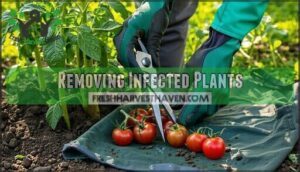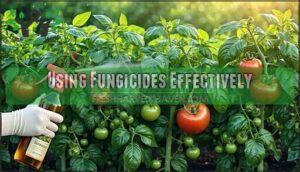This site is supported by our readers. We may earn a commission, at no cost to you, if you purchase through links.

Start by pruning all infected leaves and stems, cutting six inches below visible damage to stop the spread. Apply copper-based fungicides or baking soda spray every 7-14 days, coating both leaf surfaces thoroughly.
Improve air circulation by spacing plants properly and removing lower branches that touch the soil. Avoid overhead watering since blight thrives in humid conditions.
Water at the base instead, and consider adding mulch to prevent soil splash. Severely infected plants might need removal to protect your remaining crop.
The secret lies in understanding which treatment works best for each blight type. Act quickly and use the right methods to save your plants from this fungal foe and ensure a healthy crop by applying the right treatment at the right time to prevent humid conditions.
Table Of Contents
- Key Takeaways
- Tomato Blight Overview
- Treating Tomato Blight
- Identifying Blight Signs
- Preventing Blight Spread
- Managing Blight Infestation
- Controlling Blight Outbreaks
- Frequently Asked Questions (FAQs)
- How can I prevent tomato blight?
- How to treat Late Blight in tomatoes?
- What is the best tomato blight treatment?
- Can tomato blight be treated indoors?
- Can tomatoes recover from blight?
- What is the best spray for tomato blight?
- Does baking soda work for tomato blight?
- How do you remove blight from tomatoes?
- Can tomato blight spread to other vegetables?
- Can I eat tomatoes with blight?
- Conclusion
Key Takeaways
- Act fast when you spot blight symptoms – Remove infected leaves and stems immediately, cutting six inches below visible damage, and dispose of them in sealed bags to prevent spores from spreading to healthy plants.
- Apply targeted treatments consistently – Use copper-based fungicides or baking soda spray every 7-14 days, coating both leaf surfaces thoroughly, and do not skip applications even when symptoms seem to improve.
- Improve air circulation and watering practices – Space your plants properly, remove lower branches touching soil, and water at the base instead of overhead to reduce the humid conditions that blight thrives in.
- Monitor your plants weekly and practice prevention – Check for early warning signs on lower leaves, rotate crops annually, choose blight-resistant varieties, and maintain good garden hygiene to catch problems before they destroy your harvest.
Tomato Blight Overview
Tomato bl is a fast-spreading disease that can wipe out your plants almost before you notice a problem.
By understanding its symptoms and causes, you can take quick action to protect your tomatoes.
Early Blight Symptoms
Early blight symptoms often start on the lower leaves as dark brown spots with distinct concentric rings.
Spotting those telltale dark rings on lower leaves? That’s early blight making its debut—catch it fast!
You might notice yellow halos around these spots, signaling blight progression.
As the disease spreads, affected leaves wilt and fall off, revealing stem lesions.
Catching these tomato disease symptoms early can save your plants and prevent further damage from this common tomato plant blight.
Late Blight Symptoms
Unlike early blight’s ground-up attack, late blight symptoms often hit the canopy first.
Look for brown or tan leaf appearance with a light yellow halo. Stem lesions may show dark, fuzzy growth.
Fruits develop leathery, sunken rot, starting at the top. This tomato disease spreads incredibly fast, especially in cool, wet weather—spot it early to slow its destructive trail.
You can also improve plant health by using organic mulching options.
Septoria Leaf Spot Symptoms
Septoria leaf spot is a common headache among tomato diseases.
You’ll notice tiny, dark leaf spots that grow larger, often with light centers.
Watch out for:
- Spot Identification: Small brown spots appearing on lower leaves.
- Lesion Appearance: Dark borders surrounding spots.
- Disease Progression: Leaves yellowing and falling.
- Affected Areas: Lower leaves first.
- Symptom Mimicry: It mimics other fungal infections—stay vigilant.
Treating Tomato Blight
When it comes to tomato blight treatment, acting fast makes all the difference.
Time is your greatest weapon against tomato blight—hesitate, and you’ll watch your garden disappear overnight.
Start by removing infected leaves and stems—think of it as a clean-up crew for your plants. Burning or bagging the infected parts guarantees the spores don’t spread.
For a more hands-off approach, fungicide application works wonders. Consider organic treatments like copper-based fungicides if you’re avoiding chemicals.
Pruning strategies also help by improving airflow, keeping leaves dry, and reducing blight-friendly conditions. Don’t forget soil amendments like compost or balanced fertilizers to keep plants strong.
One key is to look for varieties with EB notation on seed packets to guarantee some early blight resistance. And at the time fruits ripen, adopt careful harvesting techniques to avoid bruising, as damaged fruit is more prone to rot.
Tomato blight treatment for tomatoes might sound challenging, but consistency is key to winning.
Identifying Blight Signs
Spotting blight early can save your tomato plants from a quick decline.
Look for telltale signs like spots on leaves, stem discoloration, or unsightly patches on fruit before the damage spreads.
Leaf Spot Diseases
Tomato leaves don’t whisper their troubles, but spotting disease gives you the upper hand.
Look for these common leaf spot diseases:
- Alternaria Solani: Brown circles with concentric rings.
- Septoria Lycopersici: Tiny black dots with yellow halos.
- Late Blight Lesions: Oily, purple-brown patches.
- Diseased leaves wilt fast, speeding disease progression.
- Blight Identification depends on tracking spot shapes and patterns.
Spot it early, act fast!
Stem and Fruit Damage
Spotting stem lesions and fruit rot means tomato blight is hitting hard.
Stems blacken, turn stringy, and can collapse completely, while fruit shows brown, leathery spots that scream trouble.
Blight severity reduces yield impact dramatically.
Identifying damage early helps; consider tomato blight treatment options like a fungicide for blight to save unaffected crops.
Catch this tomato disease fast!
Environmental Factors
Blight thrives when nature plays dirty, making weather conditions, humidity levels, and sunlight exposure huge factors.
High moisture and poor air circulation create a blight playground. Stay sharp by monitoring these:
- Humid days: Blight loves them; moisture sticks around longer.
- Crowded plants: Block airflow, boosting fungus risks.
- Shady hours: Less sunlight means damp leaves linger.
Smart environmental controls can save your crop! Poor soil quality can also foster disease.
Preventing Blight Spread
You can stop blight from spreading by focusing on smart gardening habits like crop rotation, proper watering, and mulching.
These simple steps protect your plants, reduce moisture on leaves, and create a barrier against soil-borne spores, which is a key part of proper watering.
Crop Rotation Methods
Switching up crops is like vacation for your soil—plant rotation keeps it fresh and healthy.
Avoid the nightshade family back-to-back; instead, try nonhost crops like onions or beans to disrupt soilborne pathogens.
Rotation frequency matters too—every two to three years works wonders.
Companion planting adds a bonus by boosting nutrient management and helping your garden thrive naturally.
Water Management Techniques
Get a handle on moisture with these watering techniques:
- Use drip irrigation or a soaker hose for controlled water delivery.
- Water plants early in the morning to support humidity control.
- Improve drainage solutions to keep roots healthy.
- For small gardens, a water wand or longneck watering can work wonders.
Smart water conservation prevents soggy soil and helps fight tomato blight!
Improving soil health, including adding organic matter, further strengthens plants against blight.
Mulching Benefits
Mulching works wonders for your garden by stabilizing soil temperature and locking in moisture retention.
Organic mulch, like shredded wood mulch, simultaneously suppresses weeds and delivers nutrients as it decomposes.
It’s like giving your plants a protective blanket against soil-born diseases.
Plus, it prevents soil splashing during rain, reducing risks of blight and keeping your tomatoes healthier.
Using specific tomato mulches can further enhance these benefits by providing a protective layer for your plants.
Managing Blight Infestation
When blight strikes, you’ve got to act quickly to stop its spread and save your plants.
Removing infected leaves, using targeted fungicides, and trying natural solutions can help you regain control in no time, with quickly being the key to preventing further damage.
Removing Infected Plants
When battling tomato blight, early removal of infected plants is your first line of defense.
Carefully uproot them, ensuring roots and debris don’t stay behind. Practice safe disposal—bag or burn them, never compost.
Sanitize your tools to stop spreading spores. Blight identification is key, so check your garden often.
Consider replanting options with blight-resistant varieties for better blight control.
Using Fungicides Effectively
Use fungicides wisely for tomato blight by picking the best fungicide types like copper-based options or systemic sprays.
Timing matters—apply before blight spreads for top results. Stick to label instructions for dosage accuracy, as overuse leads to resistance management challenges.
Tomato blight spray works best when rotated with other products. Handle all fungicides safely—gloves aren’t optional!
For persistent fungal issues, consider using a Bordeaux mixture.
Biological Control Methods
Switching to organic treatments, biological control tackles blight with Beneficial Microbes like Bacillus subtilis, a natural biofungicide.
These tiny natural predators suppress disease while boosting soil health. Think of them as your plant’s defense team!
Organic sprays help maintain blight control, especially during humid spells. To manage the disease, consider using copper-based fungicides.
Consistent application guarantees effective organic blight control, keeping your garden healthier without relying solely on chemical solutions, using natural biofungicide and biological control for a better outcome.
Controlling Blight Outbreaks
You can keep blight outbreaks under control by choosing resistant tomato varieties, practicing good garden hygiene, and monitoring plants regularly.
Proper care and quick action make a big difference in saving your crop from this destructive disease, which is why proper care is essential.
Choosing Resistant Varieties
Blight-resistant tomatoes offer a great defense against outbreaks.
With hybrid vigor and smart plant breeding, varieties like ‘Defiant’ and ‘Iron Lady’ decrease disease risks.
Grafting options also exist for boosting plant health.
Always match tomato varieties to regional suitability and source seeds from trusted suppliers.
Investing in these resistant varieties minimizes headaches and maximizes yields in tough conditions, which is a key factor for smart plant breeding.
Implementing Sanitation Practices
After selecting resistant varieties, focus on garden sanitation.
Remove debris, sterilize tools, and practice soil sterilization to keep blight at bay.
Aggressive removal of infected plants helps, but composting practices matter—ensure high-heat piles.
Worker and plant hygiene are equally important; dirty hands or tools can spread spores.
Trash disposal is simple: seal infected material securely and toss it, following proper garden sanitation methods.
Monitoring Plant Health Regularly
While tomato blight can sneak up quickly, regular scouting keeps you ahead of trouble.
Early detection through consistent visual inspection makes all the difference between saving your crop and watching it fail.
Essential monitoring practices:
- Weekly plant inspection – Check leaves, stems, and fruit for suspicious spots
- Environmental monitoring – Track humidity and temperature changes that favor disease
- Record keeping – Document tomato blight symptoms and weather patterns
- Regular scouting – Focus on lower leaves where tomato disease typically starts
Frequently Asked Questions (FAQs)
How can I prevent tomato blight?
Sure, you can prevent plant diseases by ignoring basic garden hygiene—that’ll work perfectly!
Actually, keep plants dry, space them properly, stake for airflow, rotate crops annually, and remove infected leaves immediately to maintain a healthy garden, with complete concepts like these being crucial.
How to treat Late Blight in tomatoes?
Remove infected leaves immediately and destroy them in sealed bags.
Apply copper-based fungicides every 7-10 days during wet weather.
Improve air circulation by staking plants and spacing them properly to prevent further spread.
What is the best tomato blight treatment?
Prevention beats cure when battling blight. You’ll want to remove infected leaves immediately, improve air circulation, and apply copper-based fungicides every 7-10 days. Quick action saves your harvest.
Can tomato blight be treated indoors?
Indoor blight’s actually easier to tackle since you control the environment.
Remove infected leaves immediately, improve air circulation with fans, reduce humidity, and apply copper fungicide every week until symptoms disappear completely.
Can tomatoes recover from blight?
Tomatoes can’t fully recover from blight once infected.
You’ll need to remove affected plants immediately to prevent spread.
However, you can harvest uninfected fruits and save seeds from healthy plants for next season.
What is the best spray for tomato blight?
Like a firefighter choosing the right extinguisher, you’ll want copper-based fungicides for your tomato blight battle.
Bonide Liquid Copper Fungicide works best, applied every 7-10 days when conditions stay warm and wet.
Does baking soda work for tomato blight?
Baking soda can help prevent tomato blight but won’t cure existing infections.
Mix one tablespoon per gallon of water and spray weekly.
It’s more effective as prevention than treatment, so start early in the season.
How do you remove blight from tomatoes?
Blight spreads faster than gossip in a small town.
You’ll need to act swiftly—remove infected leaves immediately, dispose of them in sealed bags.
Apply copper fungicide every week to save your remaining plants.
Can tomato blight spread to other vegetables?
Yes, tomato blight can spread to other nightshade family vegetables like potatoes, peppers, and eggplants.
The spores travel through air and water, so you’ll want to keep these plants separated and practice good garden hygiene.
Can I eat tomatoes with blight?
You shouldn’t eat tomatoes affected by blight, as the disease creates brown, rotting spots that make the fruit inedible and potentially harmful.
Harvest healthy, unaffected tomatoes immediately before blight spreads further.
Conclusion
Remember, knowing how to treat tomato blight is like having a shield against garden disasters.
You’ve learned to spot early warning signs, apply targeted treatments, and prevent future outbreaks through proper spacing and watering techniques.
Stay vigilant with regular plant inspections, maintain good garden hygiene, and don’t hesitate to remove severely infected plants.
With consistent monitoring and quick action, you’ll keep your tomato plants healthy and productive throughout the growing season, ensuring a bountiful harvest despite fungal challenges.












